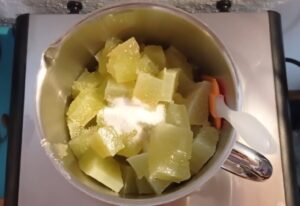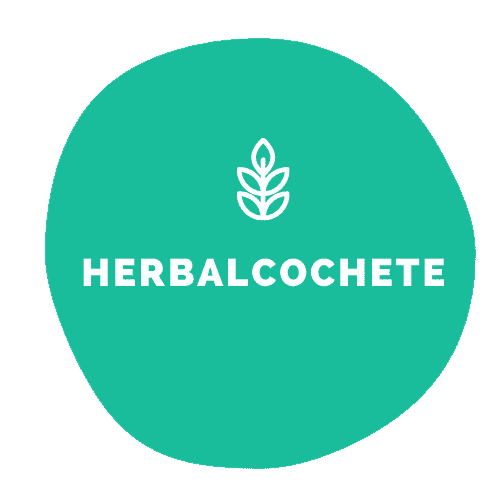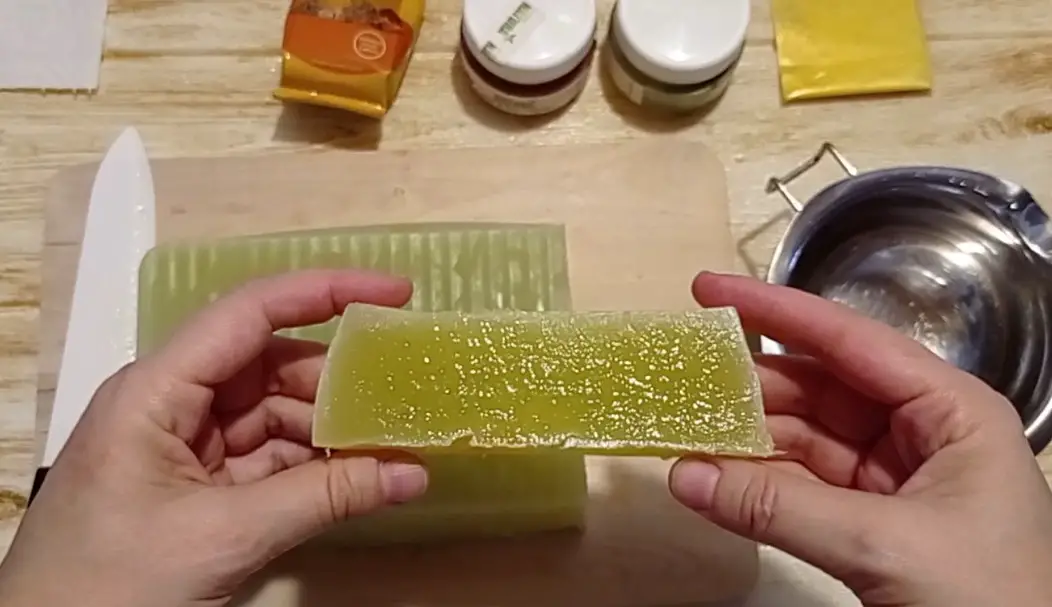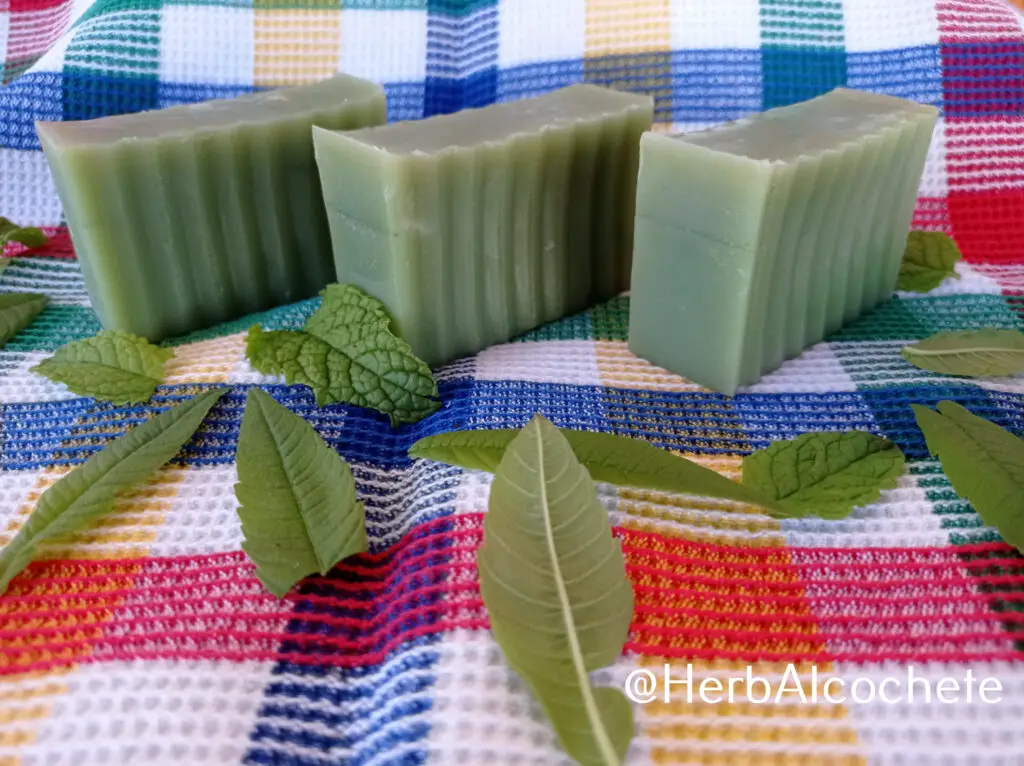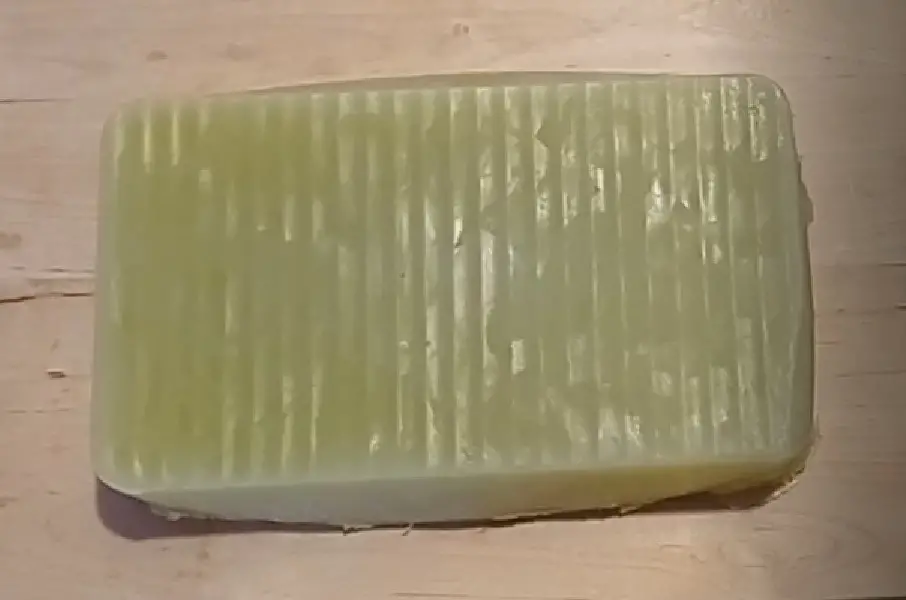It’s pretty easy to purchase a soap base and make some pretty, cute, lovely scented handmade soaps. So easy, the “challenge” of doing something might get lost after a while. The challenge of making soaps with a soap base comes back when you “have to” make your soap base at home. Here’s another soap base recipe.
This olive oil soap base recipe for melt and pour soap resulted in a very good handmade soap base: no-sweat, easily meltable, foamy and moisturizing soap base. The soaping oils are olive oil, coconut oil and castor oil. The soap base is soft when we use half of liquid oils, therefore, we need to add fine salt to harden it.
To make soap with this soap base, melt it and add addictives (including fragrances) to a maximum of 6% (so far, it was tested only up to 2,5%).
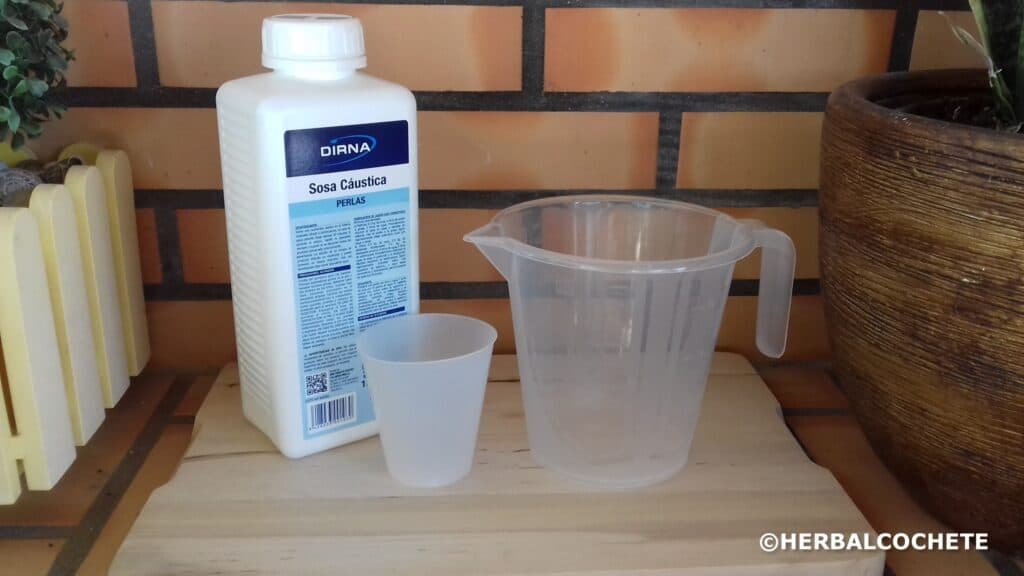
Can Olive Oil Make Soap Without Lye?
Lye it’s a basic ingredient to make soap. Soap from scratch is made with a fat like olive oil and lye water. Olive oil is great to make soap, resulting in very moisturizing, mild soap bars. However, you need lye to make soap from olive oil.
The biggest misconception is that lye is present in soap as an ingredient on its own, since it’s used as an ingredient in many cosmetic products (you can see “sodium hydroxide” listed as an ingredient). Sodium hydroxide is indeed a dangerous chemical for skin, similar to pure bleach, able to cause chemical burn.
If you check carefully a handmade soap label you will find a lot of “sodium oleate”, “sodium cocoate”, etc. These are soap salts, that resulted from the saponification of lye and olive oil or coconut oil correspondingly. There’s no lye present any longer in soap. Only soap and natural glycerin goodness. This is actually the reason why these names are presented in handmade soap labels: you make soap with lye, but there’s no pure lye present in handmade soap.
There are other kinds of “soap bars”, that uses synthetic detergents (syndet’s), called syndet bars. These bars are most likely what you will be finding in over-the-counter “soap” bars, like Dove. With syndet ingredients, you can actually make a “soap” bar with olive oil without any lye. This is how I make shampoo bars. I use syndet ingredients, water herbal infusions and natural light oils great for hair, like jojoba or argan oil.
Check out in How Do You Make a Syndet Bar? why I prefer to use syndet bars to soap bars in my hair. But let’s get back to our olive oil soap base.

What Is Olive Oil Soap Base Good For?
Any olive oil soap base will be very rich in moisturizing properties. Olive oil contains a high percentage of oleic acid, a natural and strong emmolient with anti-inflammatory properties. Olive oil may not be the best to apply directly on skin, especially if you have oily or acne-prone skin, because it might clog your skin pores. However, in soap, oleic acid adds conditioning properties without that issue.
Olive oil soap is highly moisturizing, conditioning and low-cleansing, making it the mildest of handmade soaps. It still cleans your skin, but if you have dry, aged skin or even sensitive skin, olive oil soap is perfect for you. Have in mind this soap base is a glycerin soap: it’s made with oils and lye water but it also uses solvents such as alcohol and sugar syrup to provide its clear, translucent texture. This glycerin soap base is not worse or better than castile soap, it’s simply different. Both are handmade soap, containing natural glycerin, and the moisturizing, mild properties from olive oil.
If you have tried castile soap and wish to make that soap instead, check out this Olive Oil Soap Recipe post. Olive oil as a soaping oil is described in detail in Oil Properties for Soap Making.
Is Soap With Glycerin Good For Your Skin?
All handmade soap contains glycerin. What we call “glycerin soap” is actually a sort of handmade soap that is translucid. It’s equally good to handmade soap, as they are made with same vegetable oils and lye water. The difference, as mentioned before, is the usage of solvents, like alcohol and sugar syrup. Vegetable glycerin, a well known humectant, is added to the soap to counterbalance the drying effect of solvents.
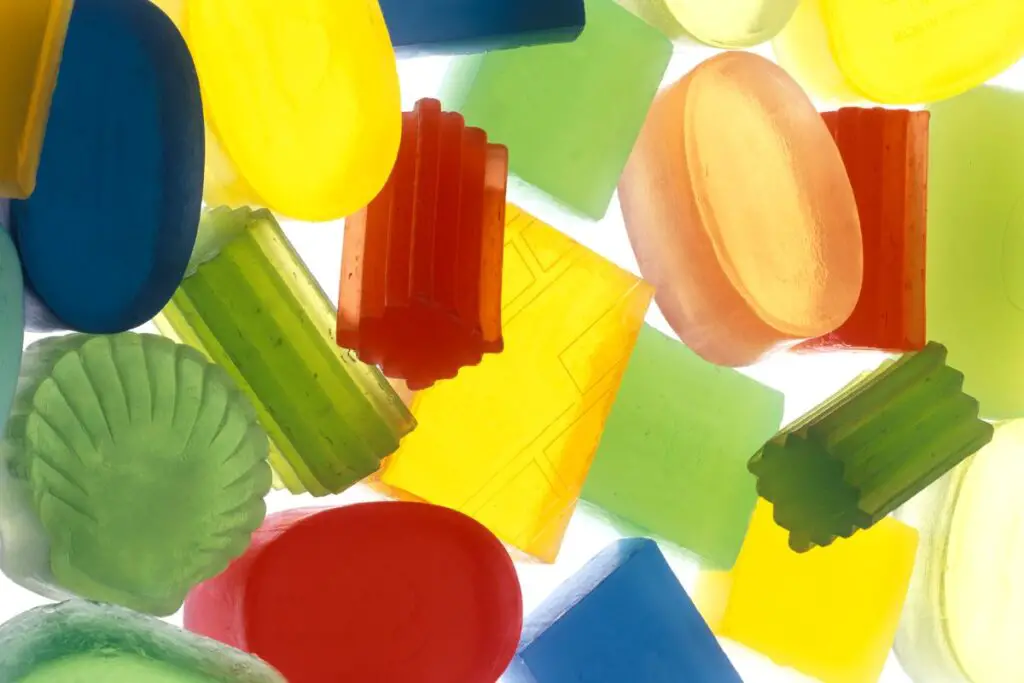
Glycerin soap, just like handmade soap, is mild to skin compared with commercial soaps and bath gels, and usually preferred by people with sensitive skin or skin problems. Sometimes, they are “life savers” where over-the-counter hygiene products failed, even the ones you purchase in pharmacies.
There’s a simple explanation for it. Usually, over-the-counter soaps contain several synthetic ingredients functioning as chelators (to enhance the soap properties), preservatives, antioxidants, color stabilizers, fragrances and fragrance fixers. They are all there to make the product stable, good looking, safe… and last for years. At the expense of ingredients that do nothing to benefit directly your skin, and in many situations even are responsible for drying skin, skin irritation or allergies.
Glycerin soap, as others handmade soaps, do not have to have product stabilizers, or preservatives. And when they do, usually they are more natural ingredients, less processed (like citric acid, for example). Therefore, they are milder and more moisturizing, since they have much less drying agents and more natural ingredients.
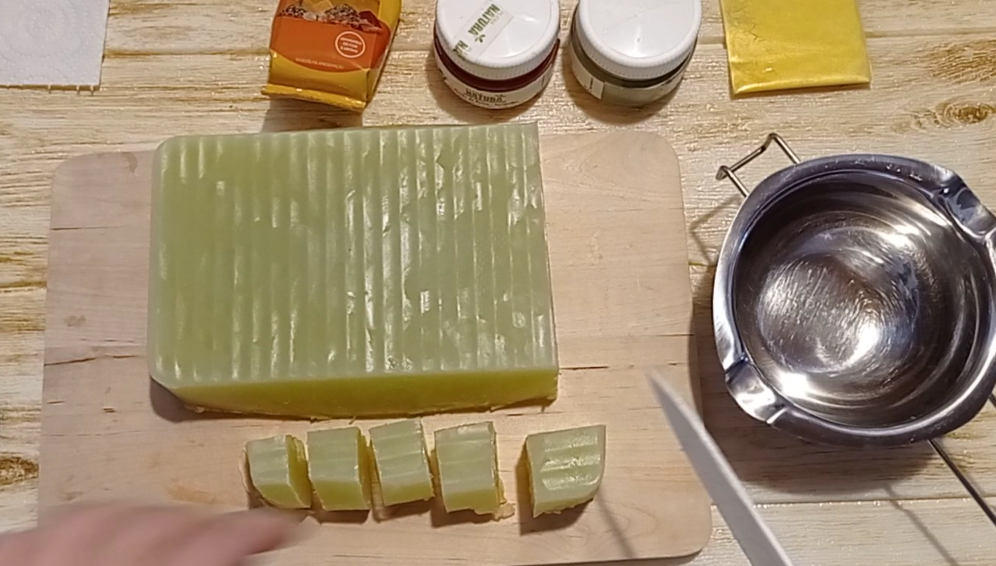
Olive Oil Soap Base Recipe
This glycerin olive oil soap base recipe is made with 55% of coconut oil, 33% of olive oil and 12% of castor oil. The soft oils can turn this soap base a little bit too soft, therefore, we add salt to help harden the soap base/soap bars.
Olive oil, as it was mentioned in the previous chapters, adds lovely moisturizing, conditioning properties to this soap, but is low-cleansing. Coconut oil counterbalances that, adding cleansing and foam to this soap base. Castor oil is great for glycerin soap, contributing to the transparent/translucid effect. It also adds bubbles to the soap.
This soap base, probably due to the added clay, doesn’t sweat. It’s also easily meltable and makes great, rich, dense, abundant foam, making it ideal as a homemade melt and pour soap base. The only drawback is the color. Olive oil adds a yellow/greenish tone to the soap that might mess up with other colors – other than green :). Other than that, it was the best soap base I’ve made at home, with great soap properties.
Curing The Soap Base
The soap base will greatly benefit from curing time, but after 2 weeks it can be used to make soap. Cure it in a well ventilated area. If it sweats, clean the dew with paper towels and, once dry, cover it with plastic film. My soap base was dry in the outside but really wet and soft inside.
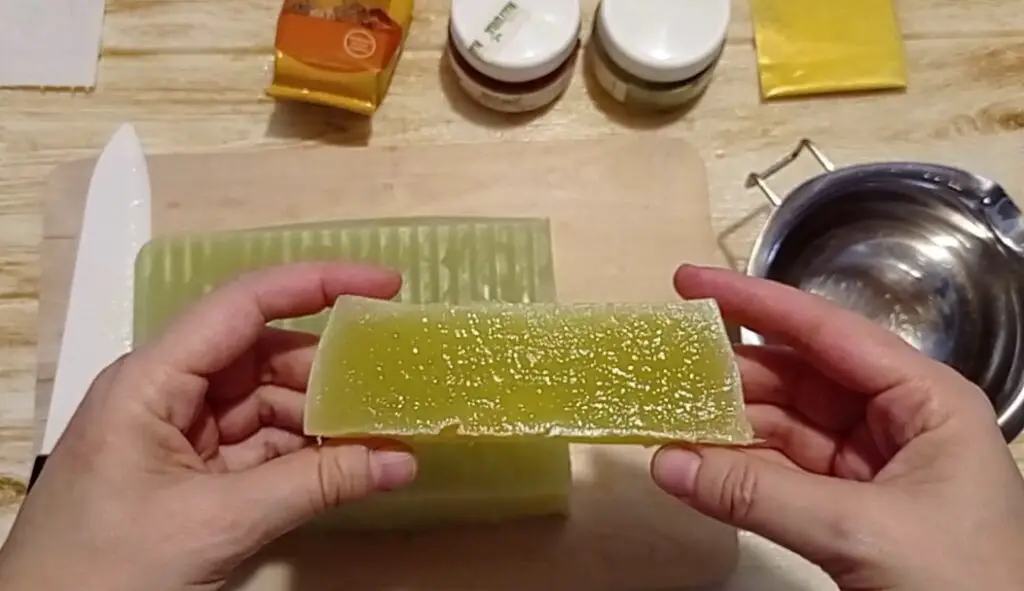
How to Use it?
Use it as any glycerin (or melt and pour) soap base. Cut the soap base in cubes, melt it, add colorants, fragrances and other addictives to a maximum of 6% (60 ml for 1Kg of soap base), and then pour it into cute soap molds.
Try this soap base recipe at home and enjoy playing with it, making cute glycerin soaps with your favorite fragrances, colorants and plant extracts!
Equipment
Ingredients
Lye Water
- 68 g lye (100% sodium hydroxide)
- 203 g distilled water
- 2 tsp fine sea salt
- 1 tsp kaolin clay white clay
Oils
- 250 g refined or organic coconut oil
- 150 g extra virgin olive oil
- 50 g castor oil
Solvents
- 140 g alcohol 96º (ethanol) grain alcohol
- 100 g vegetable glycerin
- sugar syrup
Sugar Syrup
- 110 g white sugar
- 100 g distilled water
Instructions
Get Ready!
- Wear goggles, gloves and mask! Look at “Safety Recommendations” in the video above or in How to Make Soap From Scratch
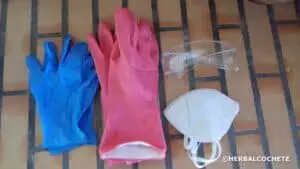
- Assemble everything: ingredients, equipment, safety equipment. Prepare your workstation, including a well ventilated area to make the lye water. Measure all the ingredients. Don’t start the recipe without having everything ready!
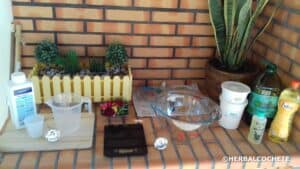
- Learn how to make sugar syrup in this video, but make sure you use the quantities indicated above: 110 g of sugar and 100 g of water. Do not let it turn into caramel – keep it thin and white.
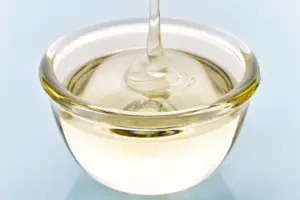
Heat the Oils
- Heat the oils up to 65 °C.Let the coconut oil fully melt.
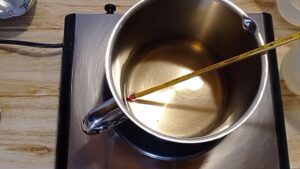
Make the Lye Water
- Make the lye solution according to How To Make Lye Water. Add the fine salt and the kaolin clay to it. Mix it until the vapors start to dissipate.
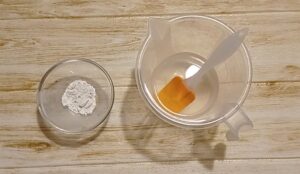
Make the Soap
- Measuring temperatures is not so critical as it is for cold process. Still, it's always a good practice to check if the lye water differs in temperature by more than 10ºC/ºF from oils. If yes, heat the oils a little bit or let the lye water cool down, to avoid volcano effects.
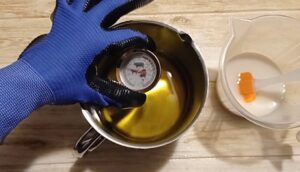
- Pour the lye water into the oils. Mix well for a few minutes with a whisker.
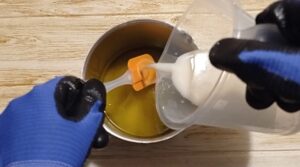
- Add the alcohol and mix well. Then add the glycerin. While you can add them seperately, I've previously mixed both ingredients in 1 pitcher.
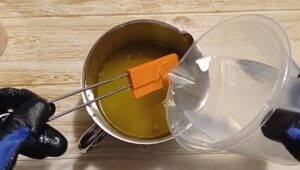
- Mix well for 10 minutes, then let it sit for 2 minutes. You can use an immersion blender, but it's not required.
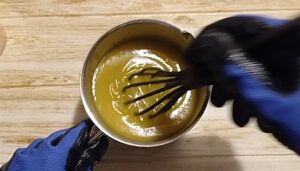
- The mixture will start to create a bit of foam/bubbles, and then will make a small "parafin-like" film at the surface. It will also smell something like jelly in the making. These are signs that the recipe is going well and your soap is saponifying.
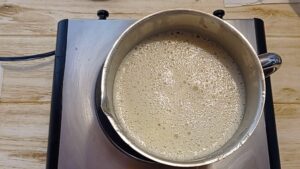
- Add the sugar syrup and continue to mix well.
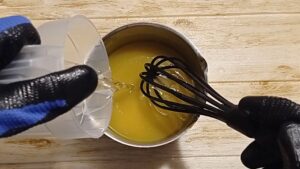
- If your soap is not showing the signs of saponification, or you are observing floating oils – the soap batter will look "oily" – , heat the mixture up to 60 °C and use an immersion blender on it for around 5 minutes.
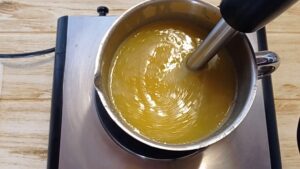
Molding and Curing
- Pour the soap into your mold. Your mold can be pretty much anything. I've used a silicone cake mold.

- Sprinkle with alcohol to remove any bubbles. Let your soap set for 24 h, in the fridge, or it won't solidify.
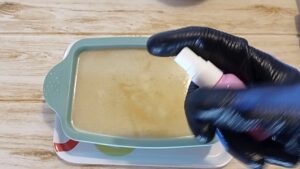
- Let it cure for 15 days. If your soap base starts to "sweat", cover it in plastic wrapping film. It shouldn't, due to the clay in it.
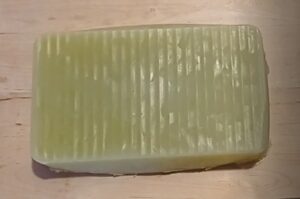
- My soap base was a bit soft: I could make a mark by pressing the soap with my finger. Inside it was partially liquid. However, the final soap was perfect, hard and dry. The soap base was quite good to melt and pour.
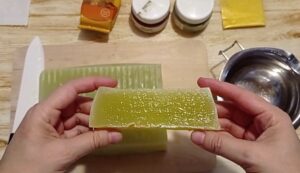
- If for some reason, the final soap made with this base is soft as well, add 1 tsp of fine salt, and re-prepare it as any melt and pour soap.
